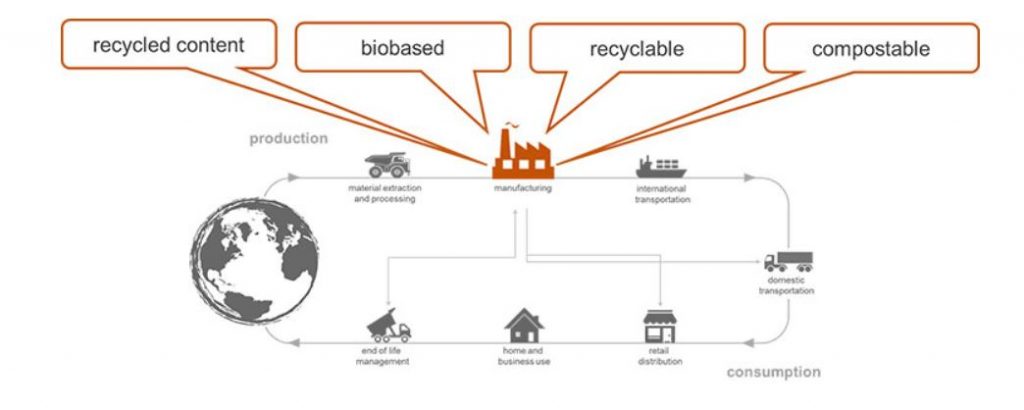Low-Impact Products and Environmental Impact Based on Characteristics and Attributes
Apr 16, 2020
We discussed low impact materials in a previous post. This post continues in that vein through the consideration of material attributes. Those of us who strive to make environmentally conscious purchasing decisions make many assumptions about the environmental impact of a product based on the characteristics or attributes of that product. These attributes include things like the origin of the material (does it contain recycled content or is it biobased) and what are its disposal options (is it recyclable or compostable). But, as we will consider in this discussion, these attributes represent the beginning and end of the story, not the full story of the environmental impacts of a product.
When we are trying to make environmentally conscious purchasing decisions, we rely on product attributes such as recycled content, biobased, recyclable, and compostable. Unfortunately, relying on these attributes alone does not account for the entire environmental impact of a product and can lead to unintended negative impacts. The majority of environmental impacts resulting from a product take place before it is discarded, during the during the extraction, processing, design, manufacturing and transportation stages. Based on information provided in an Oregon Department of Environmental Quality (ODEQ) Study, 39 percent of US greenhouse gas (GHG) emissions occur before a product reaches a consumer, and only 2 percent of GHG emissions occur from disposal (landfill, compost, and incineration). Focusing only on disposal does not allow us to reduce significant impacts earlier in the manufacturing process.

The ODEQ study reviewed 17 years’ worth of existing life cycle assessment (LCA) research to evaluate four material attributes including recycled content, biobased content, recyclable, and compostable.
The study identified two important findings related to recycled content. Generally, when choosing packaging from similar materials (such as PET plastic) the packaging with higher recycled content has lower environmental impacts – the more the recycled content, the lower the impact. When choosing packaging made of different materials (such as PET versus glass), the recycled content is not necessarily a good predictor of environmental impact. A glass container with high recycled content could have a much higher environmental impact than a container made from virgin PET plastic.
Biobased products are made from renewable materials that can be grown/replenished relatively quickly. However, because agricultural production is a significant part of the biobased packaging process and is heavily dependent upon the use of fossil fuels, fertilizers, and pesticides, the study found that the biobased attribute is generally unreliable when choosing lower impact packaging.
The study also found the recyclable attribute is also not always a good indication of lower environmental impacts. As discussed above, the environmental impact of a material is largely due to how it is produced. As a result, a recyclable steel container may have a higher environmental impact than a similarly equivalent non-recyclable flexible pouch.
Compostable packaging is often made from biobased materials, so it carries similar environmental impacts as biobased materials. Additionally, many of the materials contain additional chemicals to enhance their performance (i.e. PFAS) or do not degrade as advertised, subsequently contaminating the resulting compost.
The study concluded that there is a need to evaluate life cycle impacts in a holistic way and to develop materials to “optimize reduced life cycle burdens.” Considerations such as type of material used, and quantity of materials used are more significant than the four attributes evaluated.
For further reading, visit oregon.gov/deq/mm/production/Pages/Materials-Attributes.aspx and oregon.gov/deq/FilterDocs/packagingFS.pdf.